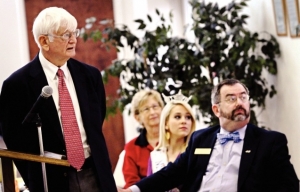Partnership for Children looks back at the year
By Phyllis Moore
Published in News on November 18, 2011 1:46 PM

News-Argus/MICHAEL BETTS
Retired pediatrician Dr. Olson Huff, left, NCPC board chairman, looks at a slide detailing a method to educate children for today's modern workplace during the Partnership for Children of Wayne County Annual Meeting at Oak Forest Church of Christ. Pictured from right are Partnership for Children of Wayne County Executive Director Charles Ivey, Miss North Carolina Hailey Best and Anne Bryan, North Carolina Early Childhood policy analyst.
Despite a year fraught with challenges, particularly with the national economy and state budget crisis, the Partnership for Children of Wayne County managed to prioritize programming needs and allocate limited resources, officials said.
The majority of the past fiscal year, which ended June 30, was spent anticipating cuts to both funding and programs. By June, Wayne County had 23 fewer child care facilities than the previous year, with 113 children on waiting lists.
And yet the local agency was able to successfully meet its goals, thanks to grants and funding support from agencies like United Way.
The value of early childhood education cannot be underestimated, said all three speakers at the Partnership's annual meeting Thursday.
Hailey Best, Miss North Carolina, said in her family, it has been a "four-generation priority."
It started with her great-grandmother, Ruth Gurley, who pioneered the opening of the first licensed child care center in Wayne County in 1953.
"Many women wanted to enter the work force but also wanted a safe learning environment for their children," she said.
Paradise Nursery was opened on George Street, and was later renamed Tiny Tot University. In 1960, a second one opened on Ash Street, Sunrise Learning Center.
Miss Best's grandmother, Sandra Mooring, continued the tradition, operating Rhyme University and, in 1973, Mount Olive Kiddie Kollege. And now her mother, Kim Best, is community service director at the Partnership.
The family has always prioritized education, "sooner rather than later," Miss Best said, as it instills such elements as responsibility and teamwork, a love of art and music, and setting future goals.
"If these skills are implemented at 2, 3, 4 years old, they'll carry through to 21," the age she is now, she said.
Anne Bryan, N.C. early childhood policy analyst for Gov. Bev Perdue, said her boss has worked diligently to offset the cuts to both Smart Start and N.C. Pre-K programs.
The governor, she said, has since identified $30 million that can be used to bring N.C. Pre-K to 6,300 more children in the coming year.
"At this point we're still in a holding pattern because there has been no word back from the General Assembly," she said. "It's not as though these children are going to wait. They're going to be 4 for a while and then they're going to be 5.
"January really gives us our last opportunity to serve these children."
While there are many issues on the table, and admitted uncertainties, Ms. Bryan said there are also "real strong glimmers of hope" for the future of early childhood education.
"We must invest in the future and it all begins here (with preschool)," said Dr. Olson Huff, a retired pediatrician and current board chairman of the N.C. Partnership for Children.
He said that in the state, there are currently an estimated 748,000 children between the ages of birth and 5 years old; 445,000 families where all parents work; and 185,000 in child care programs but only 112,000 in high quality programs.
Taking it a step further, he said that with an estimated 380,000 N.C. parents working, they contribute about $12.5 billion a year to the state's revenue.
It's important to prepare children to "go back to the future," Huff said. That can be done by providing quality preschool programs and giving children the support they need to succeed.
The Partnership, which focuses on children from birth to age 5, also provides prenatal and family resources. According to the annual report, there are an estimated 8,765 children in that age range.
For the past fiscal year, 2,930 children were in licensed or regulated care locally, with 659 on waiting lists for child care subsidies to offset costs to the family.
The county also had 38 More at Four classrooms, housed in 22 locations, including public schools, Head Start facilities and private child care centers.
